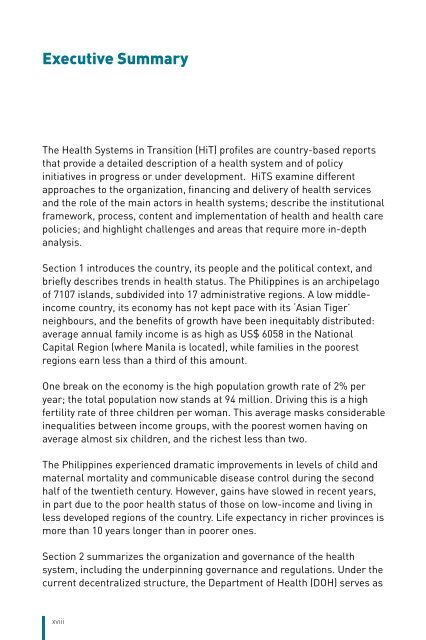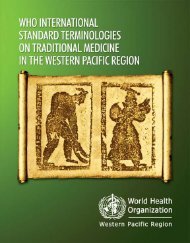The Philippines Health System Review - WHO Western Pacific ...
The Philippines Health System Review - WHO Western Pacific ...
The Philippines Health System Review - WHO Western Pacific ...
- No tags were found...
Create successful ePaper yourself
Turn your PDF publications into a flip-book with our unique Google optimized e-Paper software.
Executive Summary<strong>The</strong> <strong>Health</strong> <strong>System</strong>s in Transition (HiT) profiles are country-based reportsthat provide a detailed description of a health system and of policyinitiatives in progress or under development. HiTS examine differentapproaches to the organization, financing and delivery of health servicesand the role of the main actors in health systems; describe the institutionalframework, process, content and implementation of health and health carepolicies; and highlight challenges and areas that require more in-depthanalysis.Section 1 introduces the country, its people and the political context, andbriefly describes trends in health status. <strong>The</strong> <strong>Philippines</strong> is an archipelagoof 7107 islands, subdivided into 17 administrative regions. A low middleincomecountry, its economy has not kept pace with its ‘Asian Tiger’neighbours, and the benefits of growth have been inequitably distributed:average annual family income is as high as US$ 6058 in the NationalCapital Region (where Manila is located), while families in the poorestregions earn less than a third of this amount.One break on the economy is the high population growth rate of 2% peryear; the total population now stands at 94 million. Driving this is a highfertility rate of three children per woman. This average masks considerableinequalities between income groups, with the poorest women having onaverage almost six children, and the richest less than two.<strong>The</strong> <strong>Philippines</strong> experienced dramatic improvements in levels of child andmaternal mortality and communicable disease control during the secondhalf of the twentieth century. However, gains have slowed in recent years,in part due to the poor health status of those on low-income and living inless developed regions of the country. Life expectancy in richer provinces ismore than 10 years longer than in poorer ones.Section 2 summarizes the organization and governance of the healthsystem, including the underpinning governance and regulations. Under thecurrent decentralized structure, the Department of <strong>Health</strong> (DOH) serves asxviii
















